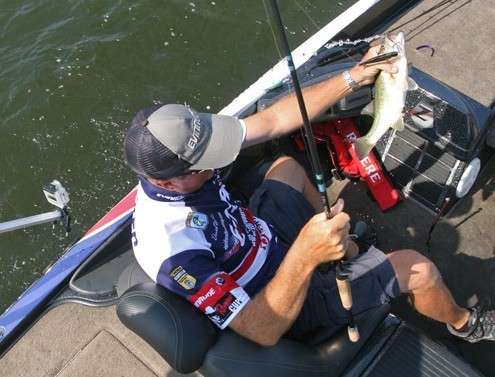
David Walker considers himself fortunate to have been paired once in a team tournament with fellow Bassmaster Elite Series pro Kelly Jordon. Those days spent with Jordan a few years ago provided a key lure that Walker used in winning the season-ending Elite Series event at Wheeler Lake in June.
That lure was the Lake Fork Tackle Flutter Spoon, which comes in three-, four- and five-inch lengths. It’s basically a big chunk of metal with a treble hook on the end.
“The first time I’d ever seen one was when we fished that PAA (Professional Anglers Association) tournament together,” Walker said. “We won that tournament, and I was fishing with Kelly.
“I fished with Kelly in the boat for a week, and that’s all we did was deep-crank and throw that big spoon. I learned how to do it that week, which was three or four years ago.”
When the water gets hot and bass start relating to deep structure, the big spoon works best. When bass are holding at depths around 20 feet, where it’s difficult to get a crankbait to run, the spoon gets there quickly and efficiently.
“It doesn’t matter how deep the fish are because the spoon will go there,” Walker said.
A key in knowing where to start throwing silverware at bass is good electronics.
“That will shorten up the day looking for them,” Walker said. “You can actually see the fish. You can just idle around looking for fish. When you see fish and baitfish and a contour break – all three together – you’ve probably got a good spot right there.”
Walker recommends a seven-foot rod with medium- to medium-heavy action.
“You don’t want a short rod,” he said. “And you’re not going to use a flipping stick. You’re going to use something in between there, along the lines you’d use for a big Texas-rigged worm.”
Walker said he has used braided line when casting spoons but calls it over-kill. Either fluorocarbon or regular monofilament will work fine. Walker notes that even working a big spoon in flooded timber you won’t lose a lure as much as you might think. The spoon essentially acts as its own plug-knocker.
“It’s surprising how much it’ll come through stuff,” he said. “Because the bait itself is so big, if you just go over there and keep dropping that line up and down, it’ll come out. Unless you get it on a trotline, then you’re done.”
Getting a free fall on a slack line is the key to working a spoon correctly. Cast it out and let it flutter all the way to the bottom – watching for strikes on the initial fall. Then retrieve it by lifting it off the bottom and letting it fall back down – moving the rod tip from nine o’clock to 12 o’clock. Some days the bass seem to want a more violent rip with the rod than others. You’ll have to experiment with that.
“It’s a line-watching deal,” Walker said. “Many times you’ll miss seeing it because there’s so much going on. But when you go to pull it up again you actually set it right into the fish. But most of the time you’ll see it. You’ll see the line jump when they hit it.
“And everything bites it – white bass, walleye. It doesn’t discriminate. I like that. You can find out what’s down there.”
Finally, Walker has one other tip that applies not only to first-time big spoon users, but first-time users of any new lure. Spend some time doing it. Remember, Walker spent a week with Jordon while learning how to use the spoon.
“If you’re really serious about learning a lure or technique, just take that one thing with you. Don’t take all the other stuff, because you’re gonna bail on the new one as soon as you’re feeling, ‘Aw, this isn’t right. But I bet I could catch one on this rig right here.’ You’ll just give up too quick.”




